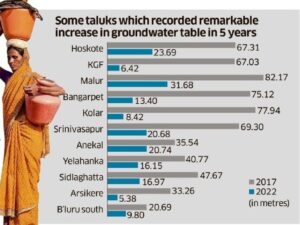Groundwater in Karnataka
Groundwater in Karnataka
Why in news? Heavy rainfall led to a steep rise in the water table in 211 out of the 233 taluks in the Karnataka state as reported by Ground Water Directorate data for this season
Highlights:
- The groundwater level in Nelamangala in Bengaluru rural district has witnessed a record increase.
- As many as 24 taluks including Hoskote, Devanahalli, Gauribidanur, Chikkaballapur, Malur, Jamkhandi and Badami have recorded at least a 10-m rise in the groundwater table.
- Groundwater is now available at a depth of 10 m in 186 taluks, mere 94 taluks had this level at the start of the monsoon.
- On the contrary, 22 taluks have recorded a marginal drop in groundwater levels of about 3 m. Nagamangala taluk in Mandya district has recorded the highest drop
- Gangavathi in Koppal district has witnessed a fall in water levels
What are the causes for ground water depletion ?
Frequent pumping of water from the ground:
- Water is pumped out more quickly than it can renew itself, leading to a dangerous shortage in the groundwater supply.
Lack of time to replenish from aquifers :
- The amount of water that aquifers hold is beyond impressive and can provide with billions of gallons of water per day.
- Groundwater is a major contributor to the Earth’s freshwater supply and is responsible for providing up to 40% of freshwater. Therefore, it doesn’t have the ability to recollect quickly enough to be continually sourced for our use.
Agriculture
- Indiscriminate drilling of borewells for supporting water intensive crops, with high MSP for this crops and subsidies on electricity will lead to depletion of ground water
Deforestation
- Due to cutting of trees, water runs off quickly as soil is unable to absorb the flowing water. Thus, water does not percolate down and groundwater level depletes.
Urbanization :
- It effects on natural recharge of aquifers due to sealing of ground with concrete and pollution of groundwater due to leakage from drainage and, industrial wastage and effluents
Groundwater depletion can also occur naturally.
- The activities that lead to groundwater depletion come mostly from humans, but a portion of it also comes from changes in our climate and can speed up the process.
What are the Effects of Groundwater Depletion?
Shallow
- A groundwater shortage keeps additional water from flowing into lakes, rivers and seas.
- Less water will enter as the existing surface water continues to evaporate and water becomes less deep, it will affect everything in that particular region, including fish and wildlife.
Increased Costs.
- As the water table lowers, the water must be pumped farther to reach the surface, using more energy. In extreme cases, using such a well can be cost prohibitive.
Contamination
- Excessive pumping in coastal areas can cause saltwater to move inland and upward, resulting in saltwater contamination of the water supply.
Reduced Surface Water Supplies.
- Groundwater and surface water are connected.
- When groundwater is overused, the lakes, streams, and rivers connected to groundwater can also have their supply diminished.
Limits biodiversity
- Many cities solely on aquifers, Wildlife, marine animals, and agriculture continues to suffer because of River runoff from industrial farming materials finds its way into the water.
Ex: Parts of Mexico City are falling as the water table lowers and creates sinkholes that destroy buildings and homes.
How to recharge ground water?
- Water from rainwater and snow melt can directly fill the aquifer-unconfined from the areas of high altitudes having openings to the unconfined aquifer.
- Rejuvenation of rivers and Overflowing rivers have also contributed to the rise in groundwater levels.
- A wetland is an area flooded with water where a number of aquatic plants and other species thrive and groundwater recharge mainly occurs at the soil present around the edges of the wetland.
- Water harvesting schemes like check dams, percolation tanks, borewell and recharge pits helps in recharging the ground water
- Percolation tank are artificially created surface water body in a highly permeable land submerged area so that the surface runoff is made to percolate and recharge the groundwater storage
Important government initiatives on management of groundwater resources
Jal Shakti Abhiyan
- Time bound campaign with a mission mode approach intended to improve water availability including ground water conditions in the water stressed blocks of 256 districts in India
“Jal Shakti Abhiyan: Catch the Rain”
- With the theme “Catch the Rain – Where it Falls When it Falls” to cover all the blocks of all districts (rural as well as urban areas) across the country
Atal Bhujal Yojana
- Central Sector Scheme, for sustainable management of ground water resources with community participation.
- Scheme is being implemented in 80 water stressed districts of seven States Gujarat, Haryana, Karnataka, Madhya Pradesh, Maharashtra, Rajasthan and Uttar Pradesh.
Master Plan for Artificial Recharge to Groundwater – 2020’.
- The Master Plan – 2020 is a macro level plan indicating various structures for the different terrain conditions of the country.
- This envisages construction of about 1.42 crore rain water harvesting and artificial recharge structures in the country to harness 185 Billion Cubic Metre (BCM).
National Aquifer Mapping and Management program (NAQUIM)
- It envisages mapping of aquifers (water bearing formations), their characterization and development of Aquifer Management Plans to facilitate sustainable management of groundwater resources in the country.
Government of India generally supports artificial groundwater recharge/water harvesting works in the country through
- Mahatma Gandhi National Rural Employment Guarantee Scheme (MGNREGS)
- Prime Minister Krishi Sinchayee Yojana – Watershed Development component (PMKSY-WDC), ‘Surface Minor Irrigation (SMI) and Repair, Renovation and Restoration (RRR) of Water Bodies schemes’ a component of PMKSY.
Question
“Composite Water Management Index”, published by NITI Aayog states that nearly 600 million people are facing high to extreme water stress. Explain the need for groundwater conservation

